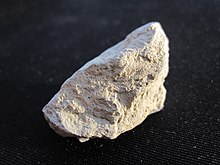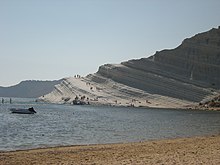Marl


Marl is an earthy material rich in
Marl makes up the lower part of the
Marl has been used as a soil conditioner and neutralizing agent for acid soil and in the manufacture of cement.
Description

Marl or marlstone is a
Marlstone is an indurated (resists crumbling or powdering) rock of about the same composition as marl. This is more correctly described as an earthy or impure
Glauconitic marl is marl containing pellets of glauconite, a clay mineral that gives the marl a green color.[6] Glauconite is characteristic of sediments deposited in marine conditions.[7]
Occurrences
The lower
Marl as lacustrine sediment is common in post-
In Hungary, Buda Marl is found that was formed in the
Economic geology
Marl has been used as a
Historical use in agriculture
Marl is one of the oldest
Marl was used extensively in Britain, particularly in Lancashire, during the 18th century. The marl was normally extracted close to its point of use, so that almost every field had a marl pit, but some marl was transported greater distances by railroad. However, marl was gradually replaced by lime and imported mineral fertilizers early in the 19th century.[23] A similar historical pattern was seen in Scotland.[21]
Marl was one a few soil amendments available in limited quantities in the southern United States, where soils were generally poor in nutrients, prior to about 1840.[24] By the late 19th century, marl was being mined on an industrial scale in New Jersey[25] and was increasingly being used on a more scientific basis, with marl being classified by grade[26][27] and the state geological survey publishing detailed chemical analyses.[28]
Modern agricultural and aquacultural uses
Marl continues to be used for agriculture into the 21st century, though less frequently.[29] The rate of application must be adjusted for the reduced content of calcium carbonate versus straight lime, expressed as the calcium carbonate equivalent. Because the carbonate in marl is predominantly calcium carbonate, magnesium deficiency may be seen in crops treated with marl if they are not also supplemented with magnesium.[17]
Marl has been used in Pamlico Sound to provide a suitable artificial substrate for oysters in a reef-like environment.[29]
Portland cement
Marl has been used in the manufacture of Portland cement.
Civil engineering
The Channel Tunnel was constructed in the West Melbury Marly Chalk, a geological formation containing marl beds. This formation was chosen because of its very low permeability, absence of chert, and lack of fissures found in overlying formations. The underlying Glauconitic Marl is easily recognizable in core samples and helped establish the right level for excavating the tunnel.[33]
Marl soil has poor engineering properties, particularly when alternately wetted and dried.[34] The soils can be stabilized by adding pozzolan (volcanic ash) to the soil.[35]
Nuclear waste storage
Some marl beds have a very low permeability and are under consideration for use in the storage of
Marl lakes

A marl lake is a lake whose bottom sediments include large deposits of marl.[18] They are most often found in areas of recent glaciation[37] and are characterized by alkaline water, rich in dissolved calcium carbonate, from which carbonate minerals are deposited.[38]
Marl lakes have frequently been dredged or mined for marl, often used for manufacturing
See also
- Agricultural lime – Soil additive containing calcium carbonate and other ingredients
- Keuper marl
References
Citations
- ^ Boggs 2006, p. 172.
- ^ Pettijohn (1957), pp. 368–369.
- ^ Blatt & Tracy 1996, p. 217.
- ^ a b Pettijohn (1957), pp. 410–411.
- ^ Perri, Dominici & Critelli (2015).
- ^ Nesse 2000, p. 249.
- ^ Bristow, Mortimore & Wood 1997.
- ^ Lauridsen & Surlyk 2008.
- ^ Harris 1996, p. 57.
- ^ Krijgsman (2001).
- ^ Murphy & Wilkinson (1980).
- ^ a b c Parker 2005.
- ^ Wiik et al. (2015b).
- ^ Leeder 2011, p. 663.
- ^ Görög 2007.
- ^ a b Warncke 2015.
- ^ a b c d Jackson 1997, "marl lake".
- ^ Mathew 1993.
- ^ a b Winiwarter & Blum 2008.
- ^ a b c Dodgshon 1978.
- ^ Frossard et al. 2009.
- ^ Shannon 2020.
- ^ Sheridan 1979.
- ^ Geological Survey of New Jersey (1880), p. 184.
- ^ Woll (1896), p. 295.
- ^ New Jersey State Centennial Board (1877), p. 203.
- ^ Geological Survey of New Jersey (1887).
- ^ a b Morse & Smith 2011.
- ^ Rakhimov et al. 2017.
- ^ Soltani, Tarighat & Varmazyari 2018.
- ^ Rakhimova et al. 2018.
- ^ Rankin & Williams 2012.
- ^ Miščević 2020.
- ^ Bahadori, Hasheminezhad & Taghizadeh 2019.
- ^ Pearson & Scholtis 2021.
- ^ Duston, Owen & Wilkinson 1986.
- ^ a b Pentecost 2009.
- ^ EPA Catchments Unit 2020.
Bibliography
- New Jersey State Centennial Board (1877). Report of the New Jersey Commissioners on the Centennial Exhibition. Naar, Day, & Naar, printers. p. 203. Retrieved 2017-01-06.
- Geological Survey of New Jersey (1880). Annual Report of the State Geologist. p. 184. Retrieved 2017-01-06.
- Geological Survey of New Jersey (1887). Annual Report of the State Geologist. pp. 193–.
- Woll, F. W. (1896). "The Marls of Wisconsin". Thirteenth Annual Report of the Agricultural Experiment Station of the University of Wisconsin. Vol. 13. Madison, WI: Democrat Printing Company. p. 295. Retrieved 2017-01-06.
- Bahadori, Hadi; Hasheminezhad, Araz; Taghizadeh, Farshad (February 2019). "Experimental Study on Marl Soil Stabilization Using Natural Pozzolans". Journal of Materials in Civil Engineering. 31 (2): 04018363. S2CID 139402321.
- Blatt, Harvey; Tracy, Robert J. (1996). Petrology : igneous, sedimentary, and metamorphic (2nd ed.). New York: W.H. Freeman. ISBN 0716724383.
- Boggs, Sam (2006). Principles of sedimentology and stratigraphy (4th ed.). Upper Saddle River, N.J.: Pearson Prentice Hall. p. 172. ISBN 0131547283.
- Bristow, Roger; Mortimore, Rory; Wood, Christopher (January 1997). "Lithostratigraphy for mapping the Chalk of southern England". Proceedings of the Geologists' Association. 108 (4): 293–315. .
- Dodgshon, Robert A. (1978). "Land Improvement in Scottish Farming: Marl and Lime in Roxburghshire and Berwickshire in the Eighteenth Century". The Agricultural History Review. 26 (1): 1–14. JSTOR 40273909.
- Duston, Nina M.; Owen, Robert M.; Wilkinson, Bruce H. (December 1986). "Water chemistry and sedimentological observations in littlefield lake, michigan: Implications for lacustrine marl deposition". Environmental Geology and Water Sciences. 8 (4): 229–236. S2CID 128421594.
- Harris, C.S.; et al., eds. (1996). Engineering Geology of the Channel Tunnel. London: Thomas Telford. p. 57. ISBN 0-7277-2045-7.
- EPA Catchments Unit (28 January 2020). "Lough Carra marl lake - protecting one of Ireland's most unique and threatened habitats". Catchments.ie. Environmental Protection Agency. Retrieved 16 February 2021.
- Frossard, E.; Bünemann, E.; Jansa, J.; Oberson, A.; Feller, C. (2009). "Concepts and practices of nutrient management in agro-ecosystems: Can we draw lessons from history to design future sustainable agricultural production systems" (PDF). Die Bodenkultur. 60 (1): 43–60. Retrieved 19 March 2022.
- Görög, Péter (September 2007). "Characterization and mechanical properties of the Eocene Buda Marl". Central European Geology. 50 (3): 241–258. .
- Jackson, Julia A., ed. (1997). Glossary of geology (Fourth ed.). Alexandria, Virginia: American Geological Institute. ISBN 0922152349.
- Krijgsman, W. (2001). "Astrochronology for the Messinian Sorbas basin (SE Spain) and orbital (precessional) forcing for evaporite cyclicity" (PDF). hdl:1874/1632.
- Lauridsen, B.W.; Surlyk, F. (November 2008). "Benthic faunal response to late Maastrichtian chalk–marl cyclicity at Rørdal, Denmark". Palaeogeography, Palaeoclimatology, Palaeoecology. 269 (1–2): 38–53. .
- Leeder, M. R. (2011). Sedimentology and sedimentary basins : from turbulence to tectonics (2nd ed.). Chichester, West Sussex, UK: Wiley-Blackwell. ISBN 9781405177832.
- Mathew, W. M. (1993). "Marling in British Agriculture: A Case of Partial Identity". The Agricultural History Review. 41 (2): 97–110. JSTOR 40274955.
- Miščević, P. (2020). "Effect of drying and wetting on mechanical characteristics of Eocene flysch marl". Geotechnical hazards. Boca Raton. pp. 737–741. )
- Morse, David; Smith, Michael (2011). "Marl in the Coastal Plain of North Carolina: From Agriculture to Aquaculture". Geological Society of America Abstracts with Programs. 43 (2): 8. Retrieved 22 December 2020.
- Murphy, David H.; Wilkinson, Bruce H. (April 1980). "Carbonate deposition and facies distribution in a central Michigan marl lake". Sedimentology. 27 (2): 123–135. hdl:2027.42/72142.
- Nesse, William D. (2000). Introduction to mineralogy. New York: Oxford University Press. ISBN 9780195106916.
- Nourmohamadi, Mohammad Sadi; Abdula, Rzger A.; Albeyati, Fawzi; Sharezwri, Arkan O.; Perot, Edres M.; Jassim, Shamsadin E.; Othman, Nechirvan H. (30 November 2020). "Green Glauconitic Marl Bed As A Sequence Stratigraphical Key For Interpretation Of Contact Between Qamchuqa And Bekhme Formations In Bekhal Area, Kurdistan Region, NE Iraq". Bulletin of the Geological Society of Malaysia. 70 (1): 29–38. S2CID 229385900.
- Parker, Alan (24 July 2005). "There's Marl in Them Thar Ponds". Northern Woodlands. Center for Northern Woodlands Education. Retrieved 25 September 2020.
- Pearson, F.J.; Scholtis, A. (2021). "Controls on the chemistry of pore water in a marl of very low permeability". Water-rock interaction : proceedings of the 8th International Symposium, WRI-8, Vladivostok, Russia, 15-19 August 1995 (1st ed.). London. )
- Pentecost, Allan (December 2009). "The Marl Lakes of the British Isles". Freshwater Reviews. 2 (2): 167–197. S2CID 86157620.
- Perri, Francesco; Dominici, Rocco; Critelli, Salvatore (March 2015). "Stratigraphy, composition and provenance of argillaceous marls from the Calcare di Base Formation, Rossano Basin (northeastern Calabria)". Geological Magazine. 152 (2): 193–209. S2CID 129302757.
- Pettijohn, F. J. (1957). Sedimentary Rocks (2nd ed.). New York: Harper & Brothers. OCLC 551748.
- Rakhimov, Ravil Z.; Rakhimova, Nailia R.; Gaifullin, Albert R.; Morozov, Vladimir P. (May 2017). "Properties of Portland cement pastes enriched with addition of calcined marl". Journal of Building Engineering. 11: 30–36. .
- Rakhimova, Nailia R.; Rakhimov, Ravil Z.; Morozov, Vladimir P.; Gaifullin, Albert R.; Potapova, Ludmila I.; Gubaidullina, Alfiya M.; Osin, Yury N. (July 2018). "Marl-based geopolymers incorporated with limestone: A feasibility study". Journal of Non-Crystalline Solids. 492: 1–10. S2CID 102945891.
- Rankin, Bill; Williams, Ron (2012). "Channel Tunnel". The Geological Society. The Geological Society of London. Retrieved 1 February 2022.
- Shannon, W.D. (2020). "'An excellent improver of the soil': Marl and the landscape of lowland Lancashire". Agricultural History Review. 68 (2): 141–167. Retrieved 19 March 2022.
- Sheridan, Richard C. (1979). "Chemical Fertilizers in Southern Agriculture". Agricultural History. 53 (1): 308–18. JSTOR 3742878.
- Soltani, Abolfazl; Tarighat, Amir; Varmazyari, Masoud (November 2018). "Calcined Marl and Condensed Silica Fume as Partial Replacement for Ordinary Portland Cement". International Journal of Civil Engineering. 16 (11): 1549–1559. S2CID 117404684.
- Warncke, Darryl (10 November 2015). "Lime for Michigan Soils". MSU Extension Agriculture. Michigan State University. Retrieved 26 September 2020.
- Wiik, Emma; Bennion, Helen; Sayer, Carl D.; Davidson, Thomas A.; Clarke, Stewart J.; McGowan, Suzanne; Prentice, Stephen; Simpson, Gavin L.; Stone, Laura (12 August 2015a). "The coming and going of a marl lake: multi-indicator palaeolimnology reveals abrupt ecological change and alternative views of reference conditions". Frontiers in Ecology and Evolution. 3. .
- Wiik, Emma; Bennion, Helen; Sayer, Carl D.; Davidson, Thomas A.; McGowan, Suzanne; Patmore, Ian R.; Clarke, Stewart J. (November 2015b). "Ecological sensitivity of marl lakes to nutrient enrichment: evidence from Hawes Water, UK". Freshwater Biology. 60 (11): 2226–2247. .
- Winiwarter, Verena; Blum, Winfried E. H. (June 2008). "From marl to rock powder: On the history of soil fertility management by rock materials". Journal of Plant Nutrition and Soil Science. 171 (3): 316–324. .
Further reading
- Schurrenberger, D., Russell, J. and Kerry Kelts. 2003. Classification of lacustrine sediments based on sedimentary components. Journal of Paleolimnology 29: 141–154.
